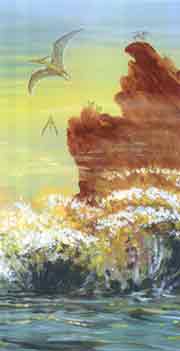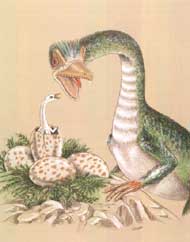 |
||||||||||
 |
||||||||||
 |
||||||||||
 |
||||||||||
|
Search
|
||||||||||
|
Titles |
||||||||||
|
|
||||||||||
 |
||||
|
Excerpt The Monsters of Blue Lagoon Jump 4: Middle Cretaceous, 110 million years B. P. We're dropping toward the seaward edge of a big continent. Offshore there's a huge string of what Dad calls barrier islands--like the Atlantic and Gulf Coast islands in our century. Mom spotted a few flowers in a zoom scan. She says this means we're no farther back than the middle Cretaceous period at most. More dinosaurs! I'm ready. Day 1, near sunset: Entry addendum by Neesha Olifee The shuttle came down near this mega-cosmic lagoon: it looked like some clear, blue-green eye full of wispy clouds. Pretty, as long as you stay clear of the crocodiles and keep an eye on whatever wanders out of the forest of odd pine trees, ferns, and pineapple-shaped things with droopy leaves. We saw a herd of long-necked dinos of some kind way down the beach. Some were wading in the lagoon. Flocks of what looked like white birds scattered when the big guys moved, then resettled on the dinos' backs. Dad looked through some binocular things he found and said the "birds" were really white-furred pterosaurs, probably looking for juicy, hide-crawling insects. Yum!
Then things got crazy. The ground shook. Twigs snapped and bushes started moving. Something made a loud bellow behind us. One majorly big, long-necked, crinkly skinned 'saur with tree-trunk-sized legs came crashing through the underbrush onto the beach. We ran like our butts were on fire. But momma dino just wanted her baby. She nudged the kid with her snout and pushed it toward the herd. By the time we got the sand and twigs out of our shoes, they were at the far end of a long line of footprints.
Resources and Maps Dinosaur Valley State Park Dinosaur Ridge forms part of the hogbacks west of Denver near Morrison, Colorado. Dinosaur trackways there tilt up at a 45-degree angle and are easily accessed by road. In 1877, a school teacher named Arthur Lakes discovered huge dinosaur bones in this area. When he sent some of the fossils to two experts, Othniel Marsh and Edward Cope, he inadvertently started an intense, twenty-year competition between these two men to find the biggest and best dinosaur bones--a competition that became so bitter it was later referred to as the "Dinosaur wars." For more information about dinosaur ridge, contact: Dinosaur Ridge Curriculum To solve this word puzzle, first group all the dinosaurs in the paragraph below into the geologic period in which they lived. For the purposes of this puzzle, assume the following: All prosauropods and coelurosaurs lived in the Triassic; all sauropods, Archeopteryx-like birds, stegasaurs, and allosaurs lived in the Jurassic; all hadrosaurs, ankylosaurs, and ceratopsians lived in the Cretaceous. Other dinosaurs are either mentioned in the text or can be looked up in the dinosaur reference. After the dinosaurs are organized by geologic period, use the first letter of their names to solve the word scramble. There will be one word from the Triassic group, two words from the Jurassic, and one word from the Cretaceous. Good Luck! Notoceratops ( a ceratopsian), Rhoetosaurus (a sauropod), Ornitholestes, Camarasaurus, Spondylosoma (a prosauropod), Regnosaurus (an ankylosaur), Placerias, Edmontosaurus, Euskelosaurus (a prosauropod from South Africa), Avipes (a coelurosaur), Mamenchisaurus, Lufengosaurus (a prosauropod from China), Osmosaurus (a relative of Stegosaurus), Eucnemisaurus (a prosauropod from South Africa), Epanterias (a type of Allosaur), Feathered dinosaurs (like Archaeopteryx), Dyplosaurus (an ankylosaur), Iguanodon, Nipponosaurus (a hadrosaur). Review Raham "transcribes" diaries kept by the two youngest members of a family of time travelers, then adds explanatory essays, places to visit, maps, sources for further information, and even games and puzzles. Ragging on one another in a brotherly/sisterly way, Jon and Neesha, with their parents, take an alien time machine to nine points in the distant past, beginning with a stop near the La Brea tar pits about 20,000 years ago, and ending in the Precambrian Era 800 million years earlier. Raham does not stint on specific detail in his supplementary material, which ranges from a plethora of mouth-filling scientific names, fossil-distribution charts, and which "dig-your-own" fossil sites in the U.S. charge admission to an extensive glossary dubbed "Neesha's Selected Guide to Big Words." Though the illustrations—a mix of simple drawings and watery-looking color scenes—are nothing to write home about compared to the technically accomplished, melodramatic dinosaur art widely available in other books, and some of the various typefaces are thin to the point of invisibility, young proto-paleontologists will find plenty of solid information as they enjoy the Olifees' breezy observations and misadventures. Grades 4-6. —John Peters |
||||
|
Fulcrum Publishing – 16100 Table Mountain Parkway, Suite 300 – Golden, Colorado 80403
|
||||
 As the shuttle got closer to Earth, the continents looked totally strange. Everyone wondered how far we'd jumped this time.
Twenty thousand years the first trip, more than 50 million years on the second, then 68 million on the third. Mom wondered if this jump would show a pattern. The big question
is, can we ever go forward again, maybe by entering the other wormhole first?
As the shuttle got closer to Earth, the continents looked totally strange. Everyone wondered how far we'd jumped this time.
Twenty thousand years the first trip, more than 50 million years on the second, then 68 million on the third. Mom wondered if this jump would show a pattern. The big question
is, can we ever go forward again, maybe by entering the other wormhole first?
 So we're all looking down the beach, not
far from the forest, when Jon says, "Quit pokin' me, grub." I told the micro-brain I wasn't anywhere near him. Jon turned around and let out a yelp. A baby long-neck was looking for something to eat
in his back pocket.
So we're all looking down the beach, not
far from the forest, when Jon says, "Quit pokin' me, grub." I told the micro-brain I wasn't anywhere near him. Jon turned around and let out a yelp. A baby long-neck was looking for something to eat
in his back pocket.